Chemo-Immunotherapy in First Line Extensive Stage Small Cell Lung Cancer (ES-SCLC): A Systematic Review and Meta-Analysis
Abstract
1. Introduction
2. Materials and Methods
2.1. Protocol and Registration
2.2. Search Strategy
2.3. Eligibility
- Patients with newly diagnosed ES-SCLC with no previous systemic treatment;
- Therapy with combined chemo-immunotherapy with any of the following ICI:
- ○
- PD-1 inhibitors;
- ○
- PD-L1 inhibitors;
- ○
- CTLA4 inhibitors.
- Comparator arm is standard of care platinum-based chemotherapy doublet including:
- ○
- Cisplatin or Carboplatin and Etoposide;
- ○
- Cisplatin or Carboplatin and Paclitaxel
- Randomised controlled trials.
2.4. Study Selection
2.5. Risk of Bias and Data Extraction
2.6. Data Items
2.7. Summary Measures and Synthesis of Results
2.8. Subgroup Analyses
2.9. Assessment of Certainty of Evidence
3. Results
3.1. Study Characteristics
3.2. Risk of Bias
3.3. GRADE Assessment
3.4. Effects of Interventions
3.4.1. Progression-Free Survival
3.4.2. Overall Survival
3.4.3. ORR
3.4.4. Duration of Response
3.5. Adverse Events
3.5.1. All Grade Adverse Events
3.5.2. Grade 3–4 Adverse Events
3.5.3. Immune-Related Adverse Events
3.6. Quality of Life
4. Discussion
5. Conclusions
Author Contributions
Funding
Conflicts of Interest
Appendix A
| # | Searches | Results |
| 1 | small cell lung cancer.mp. | 66,316 |
| 2 | exp Small Cell Lung Carcinoma/ | 3993 |
| 3 | 1 or 2 | 67,529 |
| 4 | immunotherapy.mp. | 105,565 |
| 5 | Programmed Cell Death 1 Receptor/or PD1 inhibitor.mp. or PDL1 inhibitor.mp. | 6485 |
| 6 | CTLA-4 Inhibitor.mp. | 91 |
| 7 | pembrolizumab.mp. | 3958 |
| 8 | nivolumab.mp. or nivolumab/ | 5008 |
| 9 | ipilimumab.mp. or Ipilimumab/ | 3565 |
| 10 | avelumab.mp. | 422 |
| 11 | tremelimumab.mp. | 283 |
| 12 | atezolizumab.mp. | 1067 |
| 13 | durvalumab.mp. | 503 |
| 14 | 4 or 5 or 6 or 7 or 8 or 9 or 10 or 11 or 12 or 13 | 114,500 |
| 15 | Antineoplastic Agents/ | 277,204 |
| 16 | cisplatin.mp. or Cisplatin/ | 75,659 |
| 17 | carboplatin.mp. or Carboplatin/ | 17,588 |
| 18 | Paclitaxel.mp. or Paclitaxel/ | 37,346 |
| 19 | etoposide.mp. or Etoposide/ | 25,396 |
| 20 | chemotherapy.mp. | 441,677 |
| 21 | 15 or 16 or 17 or 18 or 19 or 20 | 669,235 |
| 22 | randomised controlled trial.pt. | 507,927 |
| 23 | controlled clinical trial.pt. | 93,720 |
| 24 | randomised.ab. | 483,103 |
| 25 | placebo.ab. | 208,619 |
| 26 | drug therapy.fs. | 2,212,406 |
| 27 | randomly.ab. | 335,363 |
| 28 | trial.ab. | 509,238 |
| 29 | groups.ab. | 2,058,166 |
| 30 | 22 or 23 or 24 or 25 or 26 or 27 or 28 or 29 | 472,7391 |
| 31 | animals/ | 6,621,020 |
| 32 | human/ | 18,535,892 |
| 33 | 31 not (31 and 32) | 4,675,617 |
| 34 | 30 not 33 | 4,101,212 |
| 35 | 3 and 14 and 21 and 34 | 1125 |
| 35 | limit 34 to yr = “2010-Current” | 1040 |
Appendix B
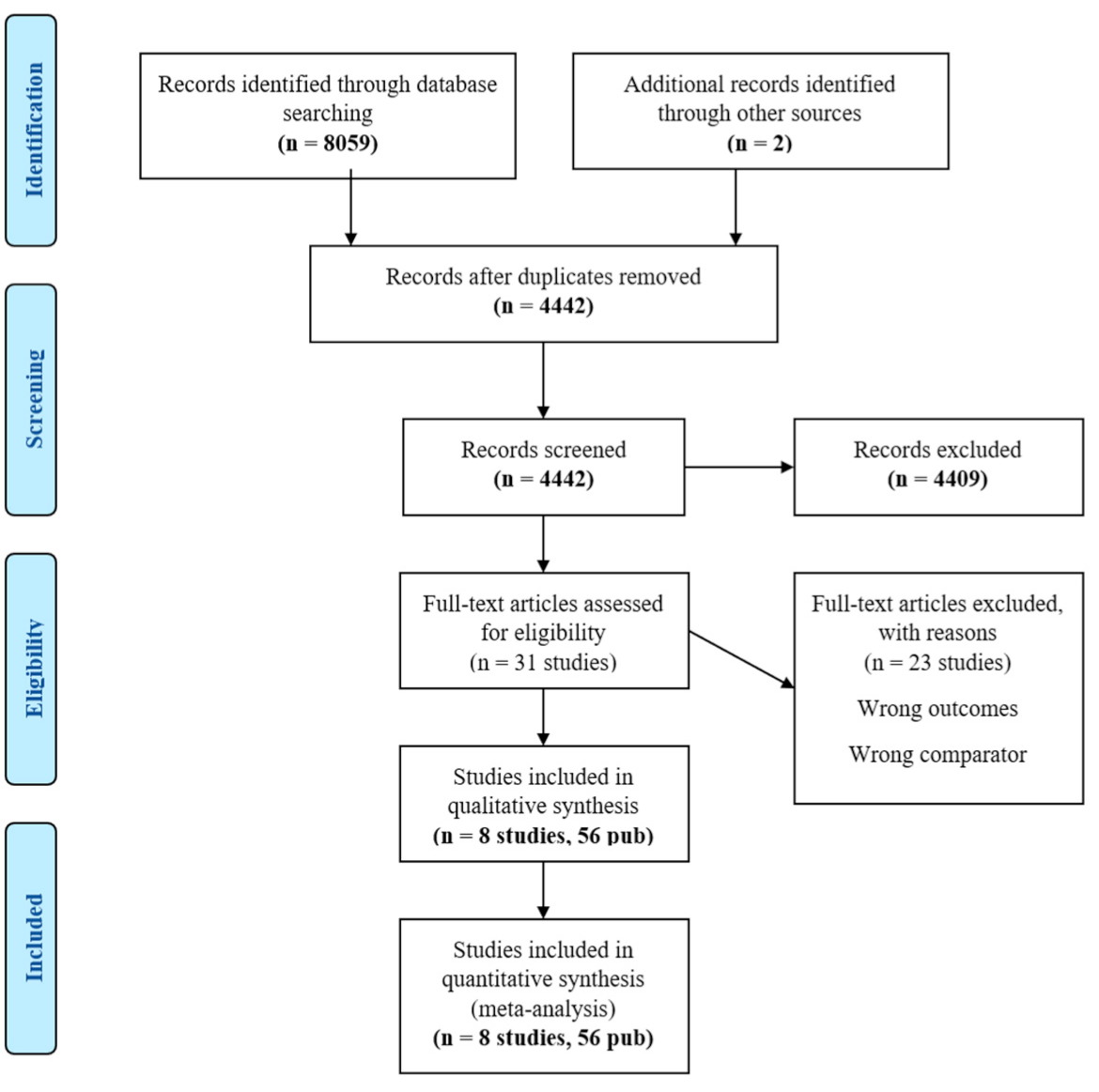
Appendix C
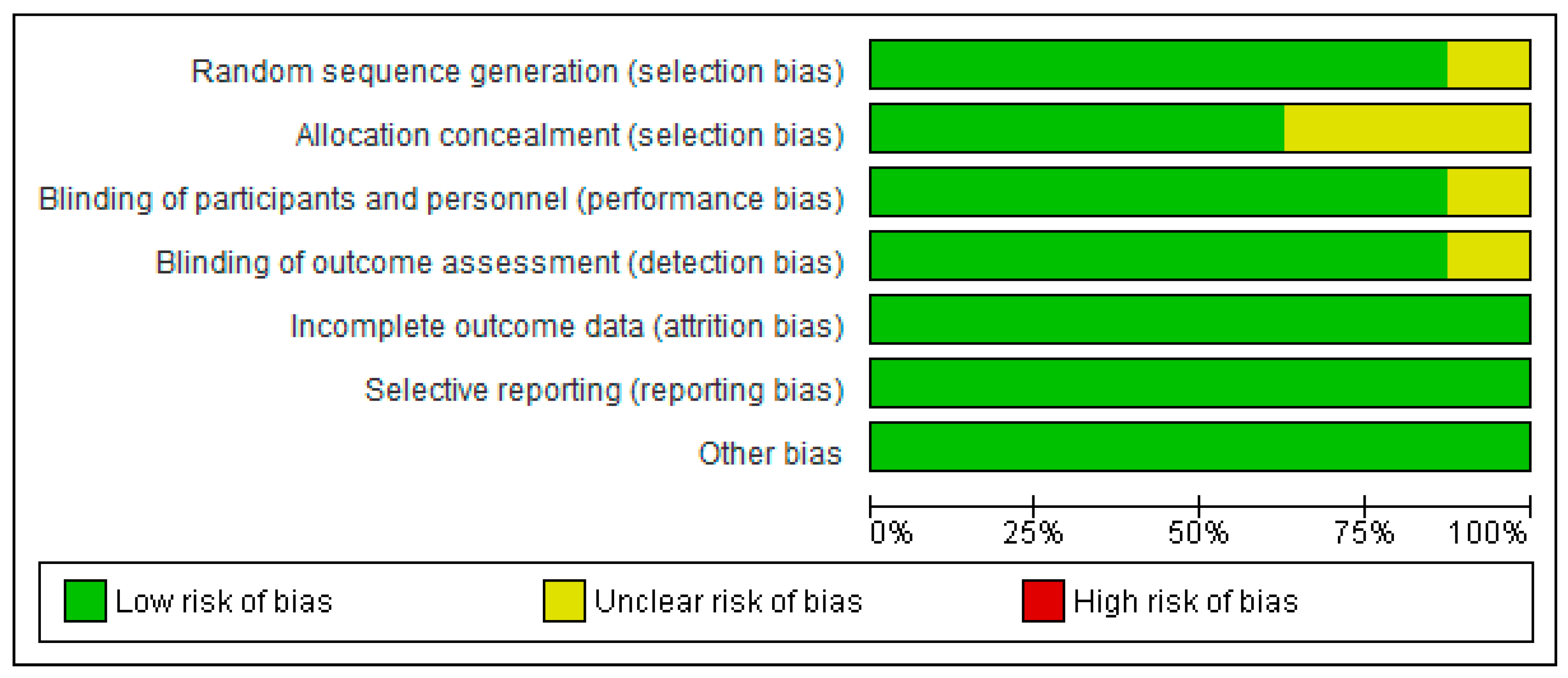
Appendix D
| Chemo-ICI compared with Chemotherapy in 1st line ES-SCLC | |||||
| Patient or population: 1st line ES-SCLC Intervention: Chemo-ICI Comparison: Chemotherapy | |||||
| Outcomes | № of Participants (Studies) Follow Up | Certainty of the Evidence (GRADE) | Relative Effect (95% CI) | Anticipated Absolute Effects | |
| Risk with Chemotherapy | Risk Difference with Chemo-ICI | ||||
| Progression-Free Survival | 3952 (10 RCTs) | ⨁⨁⨁⨁ HIGH | HR 0.75 (0.70 to 0.80) [Survival] | 6 month | |
| 238 per 1000 | 103 more per 1000 (79 more to 128 more) | ||||
| Overall Survival | 3952 (10 RCTs) | ⨁⨁⨁⨁ HIGH | HR 0.78 (0.73 to 0.84) [Survival] | 12 month | |
| 400 per 1000 | 89 more per 1000 (63 more to 112 more) | ||||
| Objective Response Rate | 3952 (10 RCTs) | ⨁⨁⨁◯ MODERATE a | RR 1.04 (0.98 to 1.10) | 601 per 1000 | 24 more per 1000 (12 fewer to 60 more) |
| Duration of Response | 2884 (6 RCTs) | ⨁⨁⨁◯ MODERATE a | - | The median duration of Response was 3.7 months | MD 0.09 months higher (0.13 lower to 0.32 higher) |
| Grade 1–4 AE | 2719 (7 RCTs) | ⨁⨁⨁◯ MODERATE b | RR 1.03 (1.01 to 1.06) | 881 per 1000 | 26 more per 1000 (9 more to 53 more) |
| Grade 1–4 AE: PD-1/PD-L1 | 1637 (4 RCTs) | ⨁⨁⨁⨁ HIGH | RR 1.02 (1.00 to 1.03) | 965 per 1000 | 19 more per 1000 (0 fewer to 29 more) |
| Grade 1–4 AE: CTLA-4 | 1082 (3 RCTs) | ⨁⨁⨁⨁ HIGH | RR 1.07 (1.00 to 1.13) | 771 per 1000 | 54 more per 1000 (0 fewer to 100 more) |
| Grade 3–4 AE | 2719 (9 RCTs) | ⨁⨁⨁◯ MODERATE a | RR 1.06 (1.00 to 1.12) | 557 per 1000 | 33 more per 1000 (0 fewer to 72 more) |
| Grade 5 AE | 2736 (6 RCTs) | ⨁⨁◯◯ LOW c | RR 1.71 (0.90 to 3.25) | 12 per 1000 | 9 more per 1000 (1 fewer to 27 more) |
| Grade 1–4 Anemia | 1499 (5 RCTs) | ⨁⨁⨁◯ MODERATE a | RR 0.98 (0.88 to 1.09) | 458 per 1000 | 9 fewer per 1000 (55 fewer to 41 more) |
| Grade 3–4 Anemia | 1644 (6 RCTs) | ⨁⨁◯◯ LOW c | RR 0.88 (0.69 to 1.12) | 149 per 1000 | 18 fewer per 1000 (46 fewer to 18 more) |
| Grade 1–4 Thrombocytopenia | 1499 (5 RCTs) | ⨁⨁◯◯ LOW c | RR 1.01 (0.85 to 1.21) | 218 per 1000 | 2 more per 1000 (33 fewer to 46 more) |
| Grade 3–4 Thrombocytopenia | 1688 (6 RCTs) | ⨁⨁◯◯ LOW c | RR 1.05 (0.79 to 1.41) | 93 per 1000 | 5 more per 1000 (19 fewer to 38 more) |
| Grade 1–4 Neutropenia | 1499 (5 RCTs) | ⨁⨁⨁◯ MODERATE a | RR 1.01 (0.90 to 1.13) | 451 per 1000 | 5 more per 1000 (45 fewer to 59 more) |
| Grade 3–4 Neutropenia | 1688 (6 RCTs) | ⨁⨁⨁◯ MODERATE a | RR 0.93 (0.81 to 1.07) | 313 per 1000 | 22 fewer per 1000 (60 fewer to 22 more) |
| Grade 3–4 Febrile Neutropenia | 1070 (3 RCTs) | ⨁⨁◯◯ LOW c | RR 0.74 (0.44 to 1.24) | 60 per 1000 | 16 fewer per 1000 (34 fewer to 14 more) |
| Grade 1–4 Fatigue | 1499 (5 RCTs) | ⨁⨁◯◯ LOW c | RR 1.06 (0.88 to 1.28) | 213 per 1000 | 13 more per 1000 (26 fewer to 60 more) |
| Grade 3–4 Fatigue | 1644 (6 RCTs) | ⨁⨁◯◯ LOW c | RR 1.68 (0.91 to 3.10) | 19 per 1000 | 13 more per 1000 (2 fewer to 39 more) |
| Grade 1–4 Nausea | 1521 (5 RCTs) | ⨁⨁⨁◯ MODERATE a | RR 1.01 (0.88 to 1.16) | 337 per 1000 | 3 more per 1000 (40 fewer to 54 more) |
| Grade 3–4 Nausea | 1543 (5 RCTs) | ⨁⨁◯◯ LOW c | RR 0.42 (0.15 to 1.19) | 14 per 1000 | 8 fewer per 1000 (12 fewer to 3 more) |
| Grade 1–4 Vomiting | 1371 (3 RCTs) | ⨁⨁◯◯ LOW c | RR 0.96 (0.75 to 1.23) | 155 per 1000 | 6 fewer per 1000 (39 fewer to 36 more) |
| Grade 3–4 Vomiting | 1374 (3 RCTs) | ⨁⨁◯◯ LOW c | RR 0.42 (0.14 to 1.28) | 15 per 1000 | 8 fewer per 1000 (13 fewer to 4 more) |
| HRQoL | (2 RCTs) | - | |||
| The risk in the intervention group (and its 95% confidence interval) is based on the assumed risk in the comparison group and the relative effect of the intervention (and its 95% CI). CI: Confidence interval; HR: Hazard Ratio; RR: Risk ratio; MD: Mean difference | |||||
| GRADE Working Group grades of evidence High certainty: We are very confident that the true effect lies close to that of the estimate of the effect Moderate certainty: We are moderately confident in the effect estimate: The true effect is likely to be close to the estimate of the effect, but there is a possibility that it is substantially different Low certainty: Our confidence in the effect estimate is limited: The true effect may be substantially different from the estimate of the effect Very low certainty: We have very little confidence in the effect estimate: The true effect is likely to be substantially different from the estimate of effect | |||||
- Effect cross null (1)
- I2 = 77%, p = 0.0002
- Events < 300 in dichotomous outcome, effect cross null
References
- Doherty, J.; Dawe, D.E.; Pond, G.R.; Ellis, P.M. The effect of age on referral to an oncologist and receipt of chemotherapy among small cell lung cancer patients in Ontario, Canada. J. Geriatr. Oncol. 2019, 10, 449–458. [Google Scholar] [CrossRef] [PubMed]
- Farago, A.F.; Keane, F.K. Current standards for clinical management of small cell lung cancer. Transl. Lung Cancer Res. 2018, 7, 69–79. [Google Scholar] [CrossRef] [PubMed]
- Rossi, A.; Di Maio, M.; Chiodini, P.; Rudd, R.M.; Okamoto, H.; Skarlos, D.V.; Früh, M.; Qian, W.; Tamura, T.; Samantas, E.; et al. Carboplatin- or cisplatin-based chemotherapy in first-line treatment of small-cell lung cancer: The COCIS meta-analysis of individual patient data. J. Clin. Oncol. 2012, 30, 1692–1698. [Google Scholar] [CrossRef] [PubMed]
- Chute, J.P.; Chen, T.; Feigal, E.; Simon, R.; Johnson, B.E. Twenty years of phase III trials for patients with extensive-stage small-cell lung cancer: Perceptible progress. J. Clin. Oncol. 1999, 17, 1794–1801. [Google Scholar] [CrossRef] [PubMed]
- Pleasance, E.D.; Stephens, P.J.; O’Meara, S.; McBride, D.J.; Meynert, A.; Jones, D.; Lin, M.L.; Beare, D.; Lau, K.W.; Greenman, C.; et al. A small-cell lung cancer genome with complex signatures of tobacco exposure. Nature 2010, 463, 184–190. [Google Scholar] [CrossRef] [PubMed]
- Peifer, M.; Fernández-Cuesta, L.; Sos, M.L.; George, J.; Seidel, D.; Kasper, L.H.; Plenker, D.; Leenders, F.; Sun, R.; Zander, T.; et al. Integrative genome analyses identify key somatic driver mutations of small-cell lung cancer. Nat. Genet. 2012, 44, 1104–1110. [Google Scholar] [CrossRef] [PubMed]
- Snyder, A.; Makarov, V.; Merghoub, T.; Yuan, J.; Zaretsky, J.M.; Desrichard, A.; Walsh, L.A.; Postow, M.A.; Wong, P.; Ho, T.S.; et al. Genetic basis for clinical response to CTLA-4 blockade in melanoma. N. Engl. J. Med. 2014, 371, 2189–2199. [Google Scholar] [CrossRef]
- Chan, T.A.; Yarchoan, M.; Jaffee, E.; Swanton, C.; Quezada, S.A.; Stenzinger, A.; Peters, S. Development of tumor mutation burden as an immunotherapy biomarker: Utility for the oncology clinic. Ann. Oncol. 2019, 30, 44–56. [Google Scholar] [CrossRef]
- Schumacher, T.N.; Schreiber, R.D. Neoantigens in cancer immunotherapy. Science 2015, 348, 69–74. [Google Scholar] [CrossRef]
- Gandhi, L.; Rodríguez-Abreu, D.; Gadgeel, S.; Esteban, E.; Felip, E.; De Angelis, F.; Domine, M.; Clingan, P.; Hochmair, M.J.; Powell, S.F.; et al. Pembrolizumab plus Chemotherapy in Metastatic Non–Small-Cell Lung Cancer. N. Engl. J. Med. 2018, 378, 2078–2092. [Google Scholar] [CrossRef]
- Paz-Ares, L.; Luft, A.; Vicente, D.; Tafreshi, A.; Gümüş, M.; Mazières, J.; Hermes, B.; Çay Şenler, F.; Csőszi, T.; Fülöp, A.; et al. Pembrolizumab plus Chemotherapy for Squamous Non-Small-Cell Lung Cancer. NEJM 2018, 379, 2040–2051. [Google Scholar] [CrossRef] [PubMed]
- Ready, N.; Farago, A.F.; de Braud, F.; Atmaca, A.; Hellmann, M.D.; Schneider, J.G.; Spigel, D.R.; Moreno, V.; Chau, I.; Hann, C.L.; et al. Third-Line Nivolumab Monotherapy in Recurrent SCLC: CheckMate 032. J. Thorac. Oncol. 2019, 14, 237–244. [Google Scholar] [CrossRef] [PubMed]
- Reck, M.; Luft, A.; Szczesna, A.; Havel, L.; Kim, S.W.; Akerley, W.; Pietanza, M.C.; Wu, Y.L.; Zielinski, C.; Thomas, M.; et al. Phase III randomized trial of ipilimumab plus etoposide and platinum versus placebo plus etoposide and platinum in extensive-stage small-cell lung cancer. J. Clin. Oncol. 2016, 34, 3740–3748. [Google Scholar] [CrossRef] [PubMed]
- Horn, L.; Mansfield, A.S.; Szczęsna, A.; Havel, L.; Krzakowski, M.; Hochmair, M.J.; Huemer, F.; Losonczy, G.; Johnson, M.L.; Nishio, M.; et al. First-line atezolizumab plus chemotherapy in extensive-stage small-cell lung cancer. N. Engl. J. Med. 2018, 379, 2220–2229. [Google Scholar] [CrossRef] [PubMed]
- Paz-Ares, L.; Dvorkin, M.; Chen, Y.; Reinmuth, N.; Hotta, K.; Trukhin, D.; Statsenko, G.; Hochmair, M.J.; Özgüroğlu, M.; Ji, J.H.; et al. Durvalumab plus platinum–etoposide versus platinum–etoposide in first-line treatment of extensive-stage small-cell lung cancer (CASPIAN): A randomised, controlled, open-label, phase 3 trial. Lancet 2019, 394, 1929–1939. [Google Scholar] [CrossRef]
- Topalian, S.L.; Hodi, F.S.; Brahmer, J.R. Safety, Activity, and Immune Correlates of Anti–PD-1 Antibody in Cancer. N. Engl. J. Med. 2012, 366, 2443–2454. [Google Scholar] [CrossRef]
- Covidence Systematic Review Software. Veritas Health Innovation, Melbourne, Australia. Available online: www.covidence.or (accessed on 1 August 2022).
- Sterne, J.A.C.; Savović, J.; Page, M.J.; Elbers, R.G.; Blencowe, N.S.; Boutron, I.; Cates, C.J.; Cheng, H.-Y.; Corbett, M.S.; Eldridge, S.M.; et al. RoB 2: A revised tool for assessing risk of bias in randomised trials. BMJ 2019, 366, l4898. [Google Scholar] [CrossRef]
- Review Manager Web (RevMan Web). The Cochrane Collaboration. 2019. Available online: https://revman.cochrane.org/ (accessed on 1 August 2022).
- Hodi, F.S. Improved survival with Ipilimumab in Patients with Metastatic Melanoma. N. Engl. J. Med. 2010, 363, 711–723. [Google Scholar] [CrossRef]
- Robert, C.; Schachter, J.; Long, G.V.; Arance, A.; Grob, J.J.; Mortier, L.; Daud, A.; Carlino, M.S.; McNeil, C.; Lotem, M.; et al. Pembrolizumab versus Ipilimumab in Advanced Melanoma. N. Engl. J. Med. 2015, 372, 2521–2532. [Google Scholar] [CrossRef]
- Robert, C.; Long, G.V.; Brady, B.; Dutriaux, C.; Maio, M.; Mortier, L.; Hassel, J.C.; Rutkowski, P.; McNeil, C.; Kalinka-Warzocha, E.; et al. Nivolumab in Previously Untreated Melanoma without BRAF Mutation. N. Engl. J. Med. 2015, 372, 320–330. [Google Scholar] [CrossRef]
- Larkin, J.; Chiarion-Sileni, V.; Gonzalez, R.; Grob, J.J.; Cowey, C.L.; Lao, C.D.; Schadendorf, D.; Dummer, R.; Smylie, M.; Rutkowski, P.; et al. Combined Nivolumab and Ipilimumab or Monotherapy in Untreated Melanoma. N. Engl. J. Med. 2015, 373, 23–34. [Google Scholar] [CrossRef]
- Paz-Ares, L.; Ciuleanu, T.E.; Cobo, M.; Schenker, M.; Zurawski, B.; Menezes, J.; Richardet, E.; Bennouna, J.; Felip, E.; Juan-Vidal, O.; et al. First-line nivolumab plus ipilimumab combined with two cycles of chemotherapy in patients with non-small-cell lung cancer (CheckMate 9LA): An international, randomised, open-label, phase 3 trial. Lancet Oncol. 2021, 22, 198–211. [Google Scholar] [CrossRef]
- Higgins, J.; Green, S. (Eds.) Cochrane Handbook for Systematic Reviews of Interventions, 5th ed.; The Cochrane Collaboration: Chichester, UK, 2011. [Google Scholar]
- Wang, J.; Zhou, C.; Yao, W.; Wang, Q.; Min, X.; Chen, G.; Xu, X.; Li, X.X.; Xu, F.; Fang, Y.; et al. Adebrelimab or placebo plus carboplatin and etoposide as first-line treatment for extensive-stage small-cell lung cancer (CAPSTONE-1): A multicentre, randomised, double-blind, placebo-controlled, phase 3 trial. Lancet Oncol. 2022, 23, 739–747. [Google Scholar] [CrossRef]
- Cheng, Y.; Han, L.; Wu, L.; Chen, J.; Sun, H.; Wen, G.; Ji, Y.; Dvorkin, M.; Shi, J.; Pan, Z.; et al. Serplulimab, a novel anti-PD-1 antibody, plus chemotherapy versus chemotherapy alone as first-line treatment for extensive-stage small-cell lung cancer: An international randomized phase 3 study. J. Clin. Oncol. 2022, 40, 8505. [Google Scholar] [CrossRef]
- Reck, M.; Bondarenko, I.; Luft, A.; Serwatowski, P.; Barlesi., F.; Chacko, R.; Sebastian, M.; Lu, H.; Cuillerot, J.M.; Lynch, T.J. Ipilimumab in combination with paclitaxel and carboplatin as first-line therapy in extensivedisease-small-cell lungcancer: Results from a randomized, double-blind, multicenter phase 2 tria. Ann. Oncol. 2013, 24, 75–83. [Google Scholar] [CrossRef] [PubMed]
- Goldman, J.W.; Dvorkin, M.; Chen, Y.H.Y.; Reinmuth, N.; Hotta, K.; Trukhin, D.; Statsenko, G.; Hochmair, M.J.; Özgüroğlu, M.; Ji, J.H.; et al. Durvalumab, with or without tremelimumab, plus platinum–etoposide versus platinum–etoposide alone in first-line treatment of extensive-stage small-cell lung cancer (CASPIAN): Updated results from a randomised, controlled, open-label, phase 3 trial. Lancet Oncol. 2021, 22, 51–65. [Google Scholar] [CrossRef]
- Rudin, C.M.; Awad, M.M.; Navarro, A.; Gottfried, M.; Peters, S.; Csőszi, T.; Cheema, P.K.; Rodriguez-Abreu, D.; Wollner, M.; Yang, J.C.H.; et al. Pembrolizumab or Placebo Plus Etoposide and Platinum as First-Line Therapy for Extensive-Stage Small-Cell Lung Cancer: Randomized, Double-Blind, Phase III KEYNOTE-604 Study. J. Clin. Oncol. 2020, 38, 2369–2379. [Google Scholar] [CrossRef]
- Leal, T.; Wang, Y.; Dowlati, A.; Lewis, D.A.; Chen, Y.; Mohindra, A.R.; Razaq, M.; Ahuja, H.G.; Liu, J.; King, D.M.; et al. Randomized phase II clinical trial of cisplatin/carboplatin and etoposide (CE) alone or in combination with nivolumab as frontline therapy for extensive-stage small cell lung cancer (ES-SCLC): ECOG-ACRIN EA5161. J. Clin. Oncol. 2020, 38, 9000. [Google Scholar] [CrossRef]
- GRADEpro Guideline Development Tool; McMaster University; Evidence Prime Inc.: Hamilton, ON, Canada 2015. Available online: https://www.gradepro.org/ (accessed on 1 August 2022).
- Ritchie, G.; Gasper, H.; Man, J.; Lord, S.; Marschner, I.; Friedlander, M.; Lee, C.K. Defining the most appropriate primary end point in phase 2 trials of immune checkpoint inhibitors for advanced solid cancers a systematic review and meta-analysis. JAMA Oncol. 2018, 4, 522–528. [Google Scholar] [CrossRef]
- Pfeiffer, B.M.; Kulakova, M.; Hashim, M.; Heeg, B. Can duration of response be used as a surrogate endpoint for overall survival in advanced non-small cell lung cancer? J. Clin. Oncol. 2018, 36, 9082. [Google Scholar] [CrossRef]
- Anagnostou, V.; Yarchoan, M.; Hansen, A.R.; Wang, H.; Verde, F.; Sharon, E.; Collyar, D.; Chow, L.Q.M.; Forde, P.M. Immuno-oncology trial endpoints: Capturing clinically meaningful activity. Clin. Cancer Res. 2017, 23, 4959–4969. [Google Scholar] [CrossRef] [PubMed]
- Liu, S.V.; Horn, L.; Mok, T.; Mansfield, A.; De Boer, R.; Losonczy, G.; Sugawara, S.; Dziadziuszko, R.; Krzakowski, M.; Smolin, A.; et al. 1781MO IMpower133: Characterisation of long-term survivors treated first-line with chemotherapy ± atezolizumab in extensive-stage small cell lung cancer. Ann. Oncol. 2020, 31, S1032–S1033. [Google Scholar] [CrossRef]
- Kim, H.; Navarro, A.; Gottfried, M. First-line pembrolizumab or placebo combined with etoposide and platinum for ES-SCLC: KEYNOTE-604 long-term follow-up. In Proceedings of the IASLC World Conference on Lung Cancer, Vienna, Austria, 9 August 2022. [Google Scholar]
- Gay, C.M.; Stewart, C.A.; Park, E.M.; Diao, L.; Groves, S.M.; Heeke, S.; Nabet, B.Y.; Fujimoto, J.; Solis, L.M.; Lu, W.; et al. Patterns of transcription factor programs and immune pathway activation define four major subtypes of SCLC with distinct therapeutic vulnerabilities. Cancer Cell 2021, 39, 346. [Google Scholar] [CrossRef] [PubMed]
- Xie, Q.; Chu, H.; Yi, J.; Yu, H.; Gu, T.; Guan, Y.; Liu, X.; Liang, J.; Li, Y.; Wang, J. Identification of a prognostic immune-related signature for small cell lung cancer. Cancer Med. 2021, 10, 9115. [Google Scholar] [CrossRef]
- Giunta, E.F.; Addeo, A.; Rizzo, A.; Banna, G.L. First-Line Treatment for Advanced SCLC: What Is Left Behind and Beyond Chemoimmunotherapy. Front. Med. 2022, 9, 1475. [Google Scholar] [CrossRef]
- Hellmann, M.D.; Rizvi, N.A.; Goldman, J.W.; Gettinger, S.N.; Borghaei, H.; Brahmer, J.R.; Ready, N.E.; Gerber, D.E.; Chow, L.Q.; Juergens, R.A.; et al. Nivolumab plus ipilimumab as first-line treatment for advanced non-small-cell lung cancer (CheckMate 012): Results of an open-label, phase 1, multicohort study. Lancet Oncol. 2017, 18, 31–41. [Google Scholar] [CrossRef]
- Antonia, S.J.; Gettinger, S.N.; Chow, L.Q.M.; Juergens, R.A.; Borghaei, H.; Shen, Y.; Harbison, C.; Chen, A.C.; Ready, N.; Rizvi, N.A. Nivolumab (anti-PD-1; BMS-936558, ONO-4538) and ipilimumab in first-line NSCLC: Interim phase I results. J. Clin. Oncol. 2014, 32, 8023. [Google Scholar] [CrossRef]
- Bennett, B.M.; Wells, J.R.; Panter, C.; Yuan, Y.; Penrod, J.R. The humanistic burden of small cell lung cancer (SCLC): A systematic review of health-related quality of life (HRQoL) literature. Front. Pharmacol. 2017, 8, 339. [Google Scholar] [CrossRef]
- Gridelli, C.; Manzione, L.; Perrone, F.; Veltri, E.; Cioffi, R.; Caprio, M.G.; Frontini, L.; Rossi, A.; Barletta, E.; Barzelloni, M.L.; et al. Carboplatin plus paclitaxel in extensive small cell lung cancer: A multicentre phase 2 study. Br. J. Cancer 2001, 84, 38–41. [Google Scholar] [CrossRef]
- Duan, J.; Cui, L.; Zhao, X.; Bai, H.; Cai, S.; Wang, G.; Zhao, Z.; Zhao, J.; Chen, S.; Song, J.; et al. Use of Immunotherapy with Programmed Cell Death 1 vs Programmed Cell Death Ligand 1 Inhibitors in Patients with Cancer: A Systematic Review and Meta-analysis. JAMA Oncol. 2020, 6, 375–384. [Google Scholar] [CrossRef]
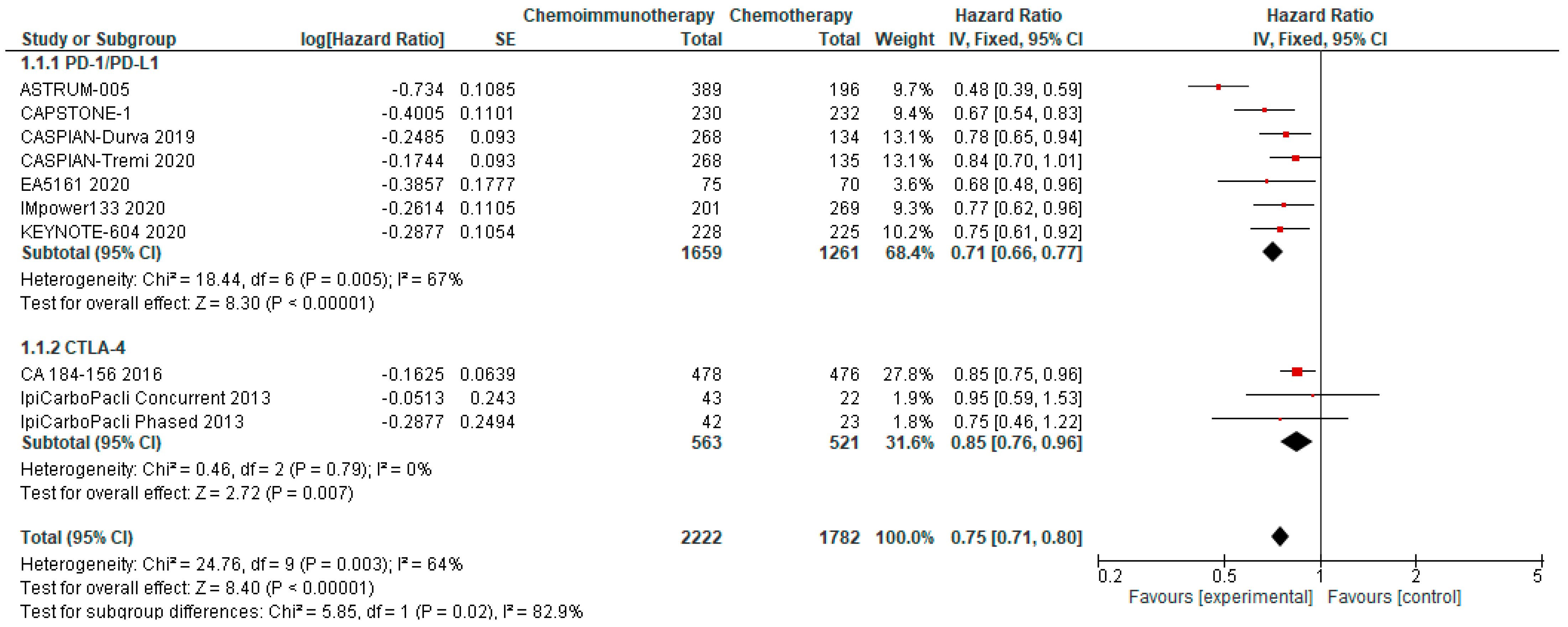
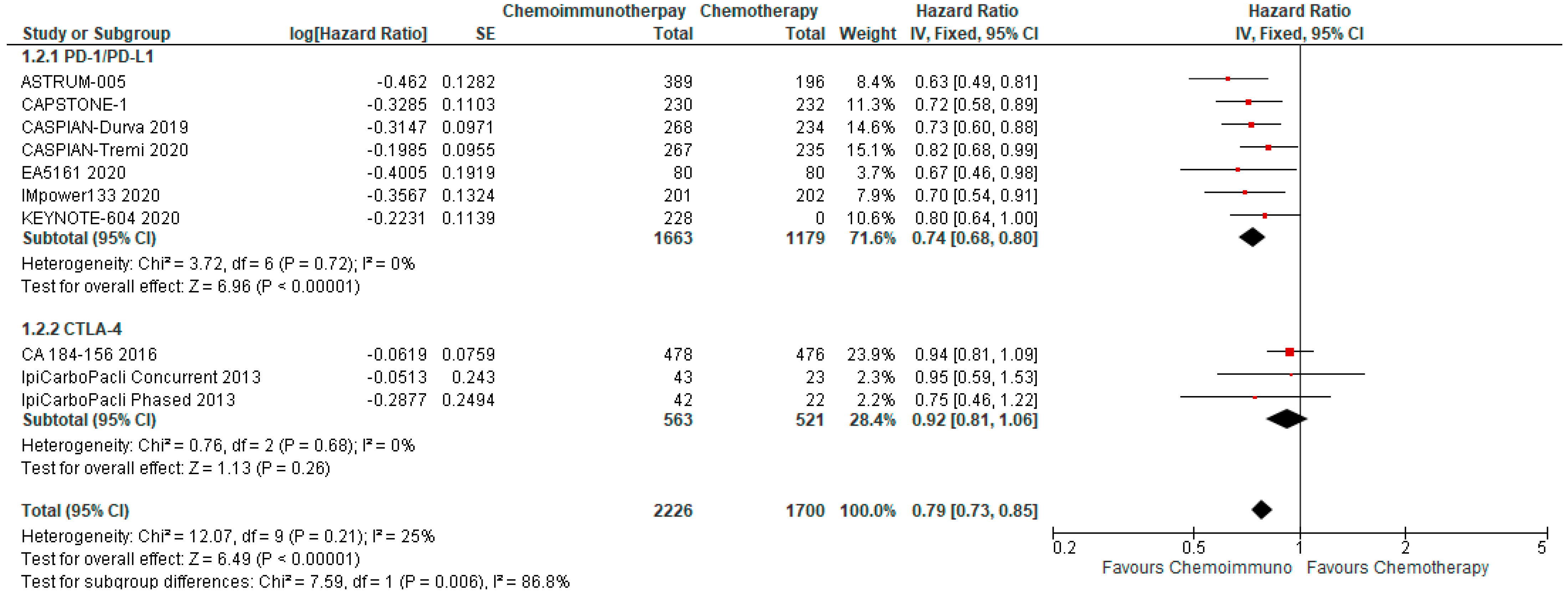
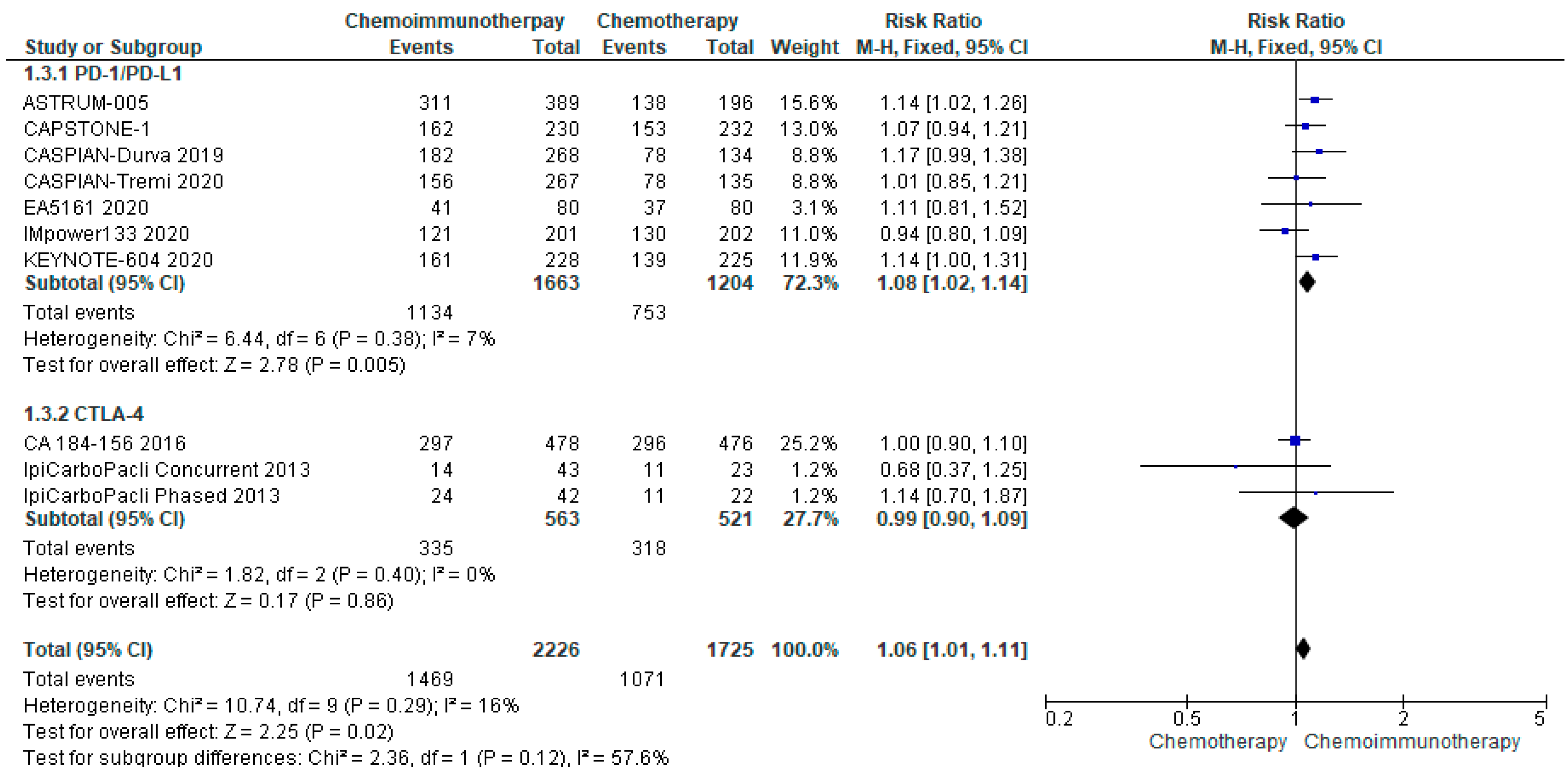
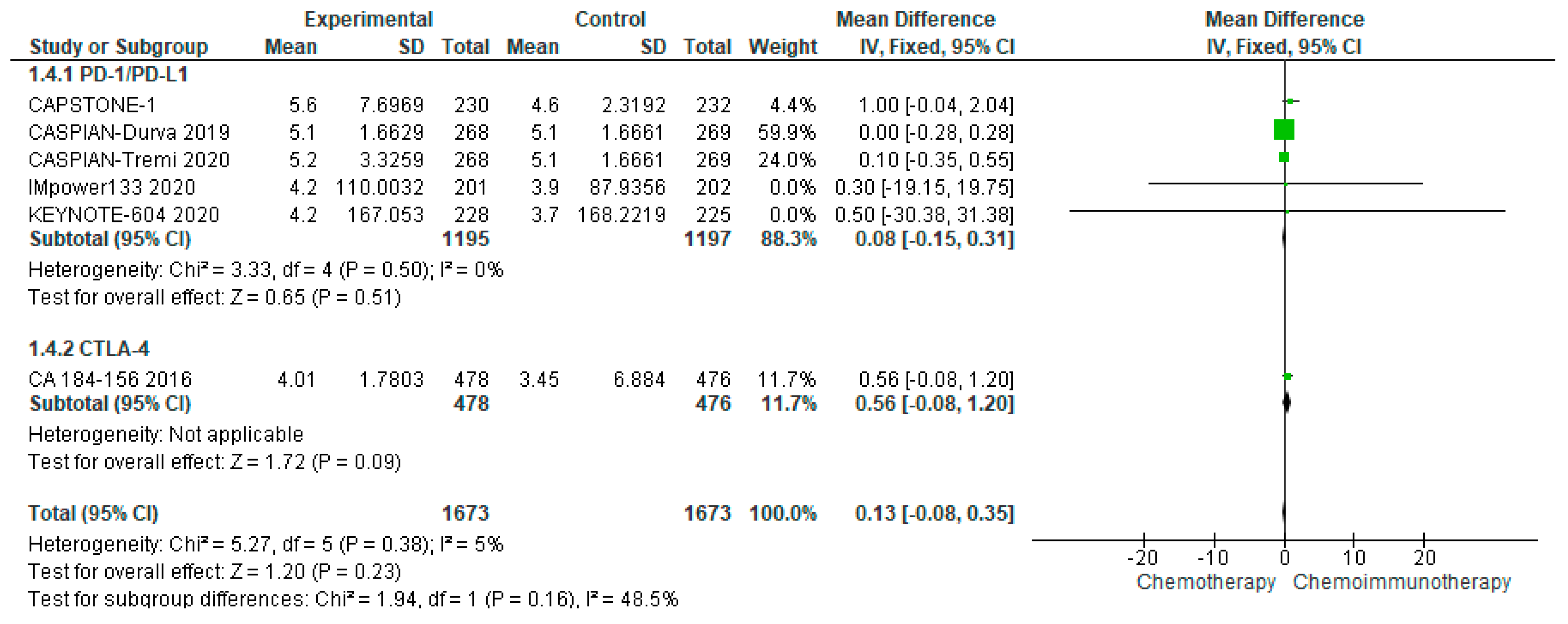
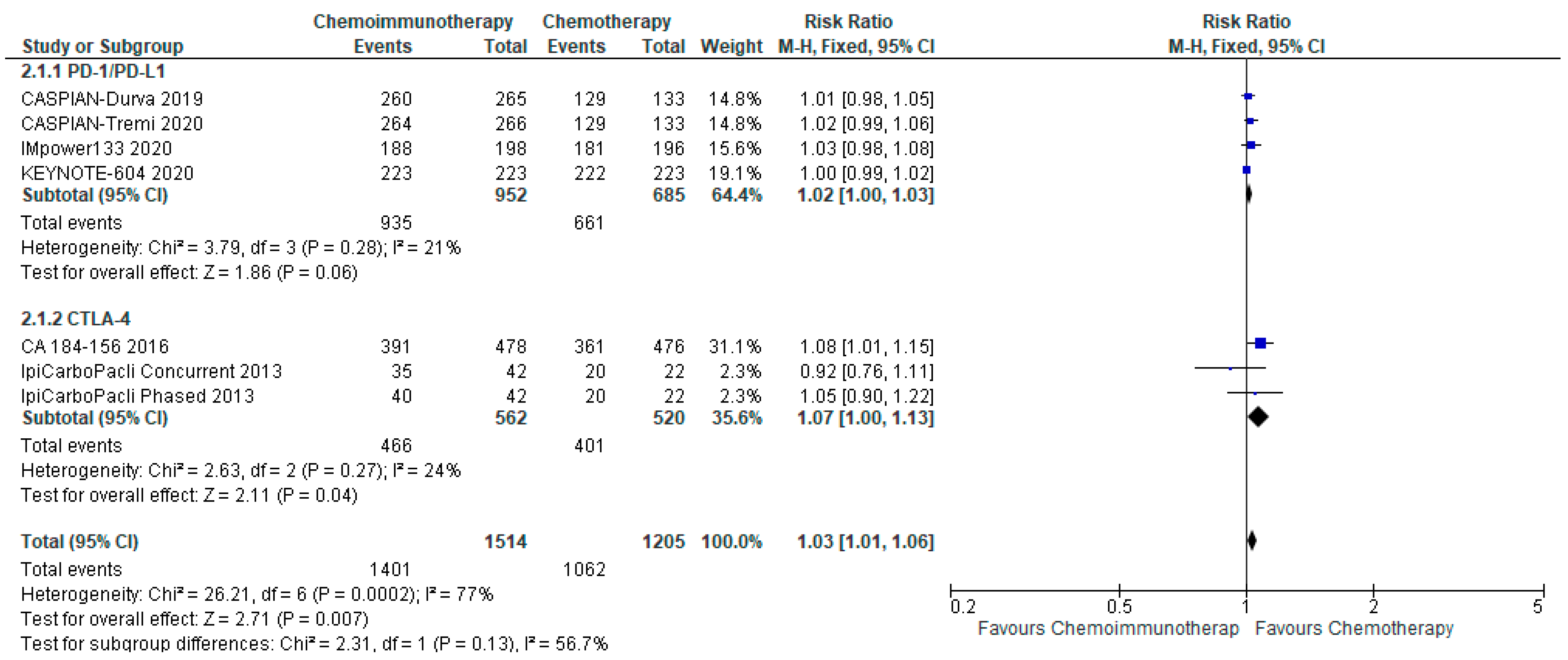

| First Author | Year | Title | Type of Publication | Type of Study | Total No. of Patients | Intervention | Comparator | Main | PCI | HR for PFS | mPFS (Treatment) | mPFS (Control) | HR for OS | mOS (Treatment) | mOS (Control) | |
|---|---|---|---|---|---|---|---|---|---|---|---|---|---|---|---|---|
| I | C | |||||||||||||||
| Wang | 2022 | CAPSTONE-1 [26] | Publication | Phase III RCT | 230 | 232 | Adebrelimab 20 mg/kg (Cycle 1–6) EP q3w × 4–6 Carbo | EP q3w × 4–6 | Y | Y | 0.67 | 5.8 | 5.6 | 0.72 | 15.3 | 12.8 |
| Cheng | 2022 | ASTRUM-005 [27] | Abstract | Phase III RCT | 389 | 196 | Serplulimab 4.5 mg/kg × 4 EP q3w × 4 Carbo | EP q3w × 4 | Y | ? | 0.48 | 5.7 | 4.3 | 0.63 | 15.4 | 10.9 |
| Reck | 2013 | CA184-041 [28] | Publication | Phase II RCT | 43 | 45 | Concurrent Ipilimumab 10 mg/kg (Cycle 1–4) Carbo/Pacli × 6 | Carbo/Pacli | Y | ? | 0.93 | 3.89 | 5.19 | 0.95 | 9.13 | 9.92 |
| Reck | 2013 | CA184-041 [28] | Publication | Phase II RCT | 42 | 45 | Phased Ipilimumab 10 mg/kg (Cycle 3–6) Carbo/Pacli × 6 | Carbo/Pacli | Y | ? | 0.93 | 5.22 | 5.19 | 0.75 | 12.94 | 9.92 |
| Reck | 2016 | CA 184–156 [13] | Publication | Phase III RCT | 566 | 566 | Phased Ipilimumab 10 mg/kg (Cycle 3–6) EP q3w × 4 Cis or Carbo | EP q3w × 6 | Y | Y | 0.85 | 4.6 | 4.4 | 0.81 | 11 | 10.9 |
| Horn | 2018 | IMpower133 [14] | Publication | Phase III RCT | 201 | 202 | Atezolizumab 1200 mg q3w EP q3w × 4 (carbo) | EP q3w × 4 | Y | Y | 0.77 | 5.2 | 4.3 | 0.70 | 12.3 | 10.3 |
| Paz-Ares | 2019 | CASPIAN [15] | Publication | Phase III RCT | 268 | 269 | Durvalumab 1500 mg q3w EP q3w × 4 Cis or carbo | EP × 6 cycles | Y | Y | 0.80 | 5.1 | 5.4 | 0.73 | 13.0 | 10.3 |
| Goldman | 2021 | CASPIAN [29] | Publication | Phase III RCT | 268 | 269 | Durvalumab 1500 mg q3w Tremelimumab 75 mg q3w EP q3w | EP × 6 cycles | Y | Y | 0.84 | 4.9 | 5.4 | 0.82 | 10.4 | 10.5 |
| Rudin | 2020 | KEYNOTE-604 [30] | Publication | Phase III RCT | 228 | 225 | Pembro EP q3w Cis or Carbo | EP q3w × 4 cycles | Y | Y | 0.73 | 4.8 | 4.3 | 0.80 | 10.8 | 9.7 |
| Leal | 2020 | EA5161 [31] | Abstract | Phase II RCT | 80 | 80 | Nivolumab 360 mg q3w EP q3w × 4 Cis or carbo | EP q3w × 4 cycles | Y | ? | 0.65 | 5.5 | 4.6 | 0.67 | 11.3 | |
| Overall | ||
|---|---|---|
| irAE (3 PDL1) | Range (%) | Median |
| Grade 1–4 * | 20–38.9 | 30.4 |
| Grade 3–4 | 5–7.2 | 6.1 |
| Grade 1–4 Colitis | 1.3–2 | 1.5 |
| Grade 3–4 Colitis | 0.4–1 | 0.4 |
| Grade 1–4 Rash | 2–18.7 | 10.35 |
| Grade 3–4 Rash | 0–2 | 0 |
| Grade 1–4 Pneumonitis | 2–4 | 3 |
| Grade 3–4 Pneumonitis | 0.5–1.3 | 1 |
| Grade 1–4 Hepatitis | 1.8–7.1 | 3 |
| Grade 3–4 Hepatitis | 1.3–6 | 1.5 |
| Grade 1–4 Nephritis | 0.5–0.9 | 0.7 |
| Grade 3–4 Nephritis | 0.4–0.5 | 0.45 |
| CASPIAN | IMpower133 | |||
|---|---|---|---|---|
| D+EP | EP | A+EP | EP | |
| Global Health Status | 56.0 | 54.1 | 51.6 | 53.7 |
| Physical Functioning | 72.2 | 70.7 | 70.7 | 71.9 |
| Pain | 28.4 | 29.5 | 33.6 | 31.9 |
| Appetite Loss | 24.2 | 25.6 | 28.9 | 27.4 |
| Cough | 41.5 | 40.5 | 42.2 | 42.9 |
| Dyspnoea | 36.5 | 38.5 | 34.3 | 29.6 |
| Fatigue | 35.3 | 37.1 | 42.0 | 38.7 |
| Insomnia | 29.7 | 33.9 | 37.6 | 34.1 |
Publisher’s Note: MDPI stays neutral with regard to jurisdictional claims in published maps and institutional affiliations. |
© 2022 by the authors. Licensee MDPI, Basel, Switzerland. This article is an open access article distributed under the terms and conditions of the Creative Commons Attribution (CC BY) license (https://creativecommons.org/licenses/by/4.0/).
Share and Cite
Sathiyapalan, A.; Febbraro, M.; Pond, G.R.; Ellis, P.M. Chemo-Immunotherapy in First Line Extensive Stage Small Cell Lung Cancer (ES-SCLC): A Systematic Review and Meta-Analysis. Curr. Oncol. 2022, 29, 9046-9065. https://doi.org/10.3390/curroncol29120709
Sathiyapalan A, Febbraro M, Pond GR, Ellis PM. Chemo-Immunotherapy in First Line Extensive Stage Small Cell Lung Cancer (ES-SCLC): A Systematic Review and Meta-Analysis. Current Oncology. 2022; 29(12):9046-9065. https://doi.org/10.3390/curroncol29120709
Chicago/Turabian StyleSathiyapalan, Arani, Michela Febbraro, Gregory R. Pond, and Peter M. Ellis. 2022. "Chemo-Immunotherapy in First Line Extensive Stage Small Cell Lung Cancer (ES-SCLC): A Systematic Review and Meta-Analysis" Current Oncology 29, no. 12: 9046-9065. https://doi.org/10.3390/curroncol29120709
APA StyleSathiyapalan, A., Febbraro, M., Pond, G. R., & Ellis, P. M. (2022). Chemo-Immunotherapy in First Line Extensive Stage Small Cell Lung Cancer (ES-SCLC): A Systematic Review and Meta-Analysis. Current Oncology, 29(12), 9046-9065. https://doi.org/10.3390/curroncol29120709




